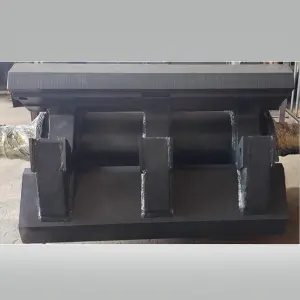Crushers play a crucial role in modern industry and are widely used in fields such as mining, construction sites, metallurgy, and chemical engineering. However, during long-term operation, the crusher may encounter the problem of rotor failure, which not only leads to production interruption but also may cause serious safety hazards. This article will explore the causes and solutions of the failure of the crusher rotor.
First, analysis of the failure causes of the crusher rotor
1. Material quality and design flaws
The selection and design of rotor material are important factors determining its durability. If the selected steel has insufficient strength, poor toughness or poor wear resistance, it is easy for the rotor to develop cracks, deformations or even fractures under long-term exposure to high impact loads. In addition, unreasonable design, such as insufficient structural rigidity of the rotor, poor dynamic balance, and improper interference fit, will also accelerate the failure process of the rotor.
2. Excessive wear and corrosion
When a crusher is processing various materials with different hardness and high impurity content, the intense friction between the rotor and the materials can cause severe surface wear, especially on vulnerable parts such as hammer heads and impact plates. Meanwhile, moisture, acidic and alkaline substances in the materials, as well as moisture and oxidation in the atmospheric environment, may cause chemical or electrochemical corrosion of the rotor components, further exacerbating their damage.
3. Overload operation and shock load
Overload operation is one of the common causes of rotor failure. When the crusher processes materials that are too hard or too large in size beyond its rated capacity, the rotor has to withstand an impact force and torque far exceeding the design value, which can easily cause the rotor to bend, develop fatigue cracks or even break. In addition, uneven feeding and the entry of hard foreign objects such as iron blocks into the crushing chamber can also cause instantaneous impact loads, which may damage the rotor.
Second, solutions to the failure of the crusher rotor
1.Optimize material selection and design
High-quality alloy steel with high strength, high toughness and high wear resistance is selected as the rotor material to ensure its durability under complex working conditions. Meanwhile, scientific and reasonable design should be carried out to enhance the rigidity of the rotor structure, optimize dynamic balance, precisely control interference fit, and reduce rotor failure caused by design flaws.
2. Strengthen protection against wear and corrosion
Regularly inspect the wear condition of the rotor and replace in a timely manner the severely worn hammer heads, impact plates and other vulnerable parts. The wear resistance of the rotor surface is enhanced by adopting wear-resistant coating, surfacing welding, heat treatment and other technologies. For corrosion issues, corrosion-resistant materials can be selected, or protective measures such as anti-corrosion coatings and electroplating can be adopted.
3. Standardize operations and avoid overloading
Establish a strict material pretreatment system to ensure that the feed particle size and hardness meet the equipment requirements and prevent hard foreign objects such as iron blocks from entering the crushing chamber. Set and monitor the operating parameters of the equipment reasonably. It is strictly prohibited to operate it under overload for a long time. Regularly carry out equipment maintenance and upkeep to promptly identify and eliminate potential hazards.
Post time: Apr-28-2025

